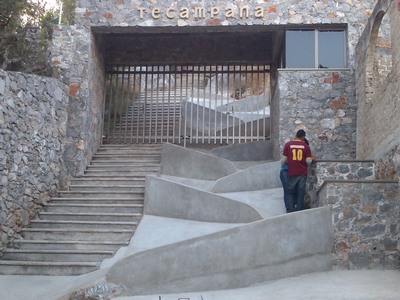As the sun lay low on the horizon, we took a little side trip to a massive uplifting of gigantic stones that tower above the city. Some of the rocks in this area are known to “sing,” emitting a deep, resonant musical tone, like a large bell, when struck with another rock.
 The locals have been coming here for centuries to make the rocks sing, and as with many such places of uniqueness, a legend has grown up to explain the phenomenon. Like Romeo and Juliette and so many other legends, this too has an element of unrequited love.
The locals have been coming here for centuries to make the rocks sing, and as with many such places of uniqueness, a legend has grown up to explain the phenomenon. Like Romeo and Juliette and so many other legends, this too has an element of unrequited love.
According to one version of the Aztec legend, on the death of King Azteca Ahuitzol, in order for his son, Tecampa , to succeed him, he had to conquer more land and bring more people into the empire. Tecampa conquered many peoples but when he came to Mexicapan, the chief, Texol, and his people battled with Tecampa for nearly a month.
Though Tecampa did not capture the city, he did succeed in capturing the springs that were the only water source, thus the people of Mexicapan were dying of thirst. Texol’s daughter, princess Na, who was always at his side, even in battle, feeling that the life of the warriors was more important than her own, volunteered to go and get water for the people, even at the cost her life.
With her maidens to accompany her, she set off for the pile of rocks where the springs were located. When she arrived, she found a strong, young warrior, the king of the Aztecs, “contemplating the infinite.” He fell instantly in love with the beautiful princess, and granted her request for water for her people under the condition that she return the next day at sunrise where he would give her not water, but his heart.
She returned the next day and Tecampa asked her to go with him to the center of his empire near the mountain of Toluca, where together they would make his people happy.
But King Texol followed his daughter that day, and upon seeing her in the arms of his mortal enemy, his heart was broken and he angrily uttered a curse that the two young lovers be turned to stone. Immediately the two bodies were merged into one large stone, one seemingly holding the other, forever. Now when a stone is touched to the rock, the young lovers sing with tenderness.
Now named Parque de Tecampana, what used to be just a local attraction, where you scrambled up the mountainside on a dirt path to climb the rocks and make your own music, the city has decided to create a real tourist attraction, with gates, paved paths, a playground, an amphitheater, bathrooms, and even exercise area at the top (though really, just climbing the hill is exercise enough!)
 Love this accessible entrance, don’t you? There is no way you could push a wheelchair up this ramp, nor the pathway above; I don’t think even my friend Shelley’s electric scooter would make it. But if you ask, the locals, they will direct you to a back entrance that is a fright to drive but takes you to a much more level path to the singing rocks.
Love this accessible entrance, don’t you? There is no way you could push a wheelchair up this ramp, nor the pathway above; I don’t think even my friend Shelley’s electric scooter would make it. But if you ask, the locals, they will direct you to a back entrance that is a fright to drive but takes you to a much more level path to the singing rocks.
 Amidst all this “beautiful,” new construction, is an old shack. It seems that the land is owned by a young man whose family has lived there for generations. The city wanted to buy the land to make it into an official park, but he refused — it was his ancestral home. Finally they made him an offer he could not refuse. Let them improve the area into a park and they will build him a better home and let him be the caretaker. A win-win — he and his ancestors, who may just be related to Tecampa and Princess Na, can continue to make the rocks sing, at least for his lifetime.
Amidst all this “beautiful,” new construction, is an old shack. It seems that the land is owned by a young man whose family has lived there for generations. The city wanted to buy the land to make it into an official park, but he refused — it was his ancestral home. Finally they made him an offer he could not refuse. Let them improve the area into a park and they will build him a better home and let him be the caretaker. A win-win — he and his ancestors, who may just be related to Tecampa and Princess Na, can continue to make the rocks sing, at least for his lifetime.
FYI — I did some research on what might make the rocks sing and came across an article by someone with some scientific background that determined that it is a combination of the type of rock, crystalline diabase, and the fact that the ringing rocks are supported on points of other rocks thus allowing them to ring rather than thud. If you want more information on ringing rocks, which occur in various places around the world, see this article about Ringing Rocks Park, in Pennsylvania. Or follow this link to hear them ring. (They kind of sound like the bell the trash collectors ring in Mexico.)
